

Copyright / Reprints
Outstanding Giant Quartz
and Sphalerite from
Mont Saint-Hilaire, Québec
By Daniel Comtois
On a sunny Sunday in August, 2002, I went with my father to the Poudrette Quarry at Mont St-Hilaire to find something new. Unfortunately for us and some other collectors, this year so far was not very productive in terms of good mineralogical finds. Most of the recent mineral exploitation at the quarry occurred in hornfells-bearing rock. Except for some minor millimeter-sized smoky quartz and altered dolomite, nothing really interesting was found. When a blast was carried out in the syenite-bearing area of the quarry, nothing but pure syenite was exposed – not a pocket to be seen anywhere! Anyway, with so much to at work this summer, I did not have much time for embarking on any major mineralogical expeditions. Around this time I went a total of four times mineral collecting, three times collecting at Mont Saint-Hilaire.
| |

Figure 1: This picture shows the old rock wall after I removed the rock debris from the upper part of the wall. The red arrows show the very altered areas. At the bottom you can see the white 5 gallon bucket we used for storing specimens.
|
After driving around the quarry, I parked my truck along an old wall of exposed rock (Figure 1). The rock face was made up of very altered pegmatite, or shall I say 'rotten' pegmatite. Everything was dark brown in colour, like the dirt. On the spot I engaged in a conversation with a fellow collector, J. Pierre Beckerich, and his son. J. Pierre is a specialist in collecting micro-minerals. After a couple of minutes we all realised that there was little chance of finding something since no recent blast occurred at the quarry. Well, I announced to my friends that even if there was little chance of finding decent mineral specimens, I was here to dig even if there was no fresh blast. I was here to relieve myself of the stress from work and to do some exercise too. So, I decided to find a spot somewhere and dig until I had had enough and then leave. Then I won't waste my day!
I turned around and started to dig at the altered wall right beside my truck. The wall was covered with open cavities that were completely rotten. Using a wood stick I could easily remove pieces as big as my fist and make them fall down from the wall. There was absolutely nothing in the cavities except millimeter sized pyrite cubes. I decided to place some of the big rocks on the ground to get better perspective of the zone. Perhaps by digging deeper into the pegmatite there was a chance of finding an unaltered area with some crystals. Anything would welcome. What other choice was there anyway? I either would dig that wall or I go back home to clean the windows, cut the grass and wash the driveway.
| |
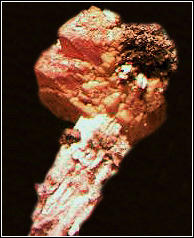
Figure 2: An amazing pink rhodochrosite specimen perched on a 2.5 cm (1 inch) long pseudomorph crystal "stick" covered with millimetre-sized donnayite crystals. The rhodochrosite is about 3 x 2.8 cm in size and is partially covered with micro-siderite.
|
After I finished cleaning out pegmatite cavity, I finally pulled out a piece about one foot long by two inches wide in the center. I see some little pockets with donnaite crystals 1-2 mm in size, rutile crystals of about 1 mm size, minor microcline and very small crystals of pink rhodochrosite 0.5 cm (about ¼ inch) in size. When I decide it's about enough, I pull out from the bottom of that pegmatite a magnificent specimen consisting of a pink rhodochrosite crystal 3 x 2.8 cm (about 1 x 1 inch) in size, partially covered with micro-siderite (Figure 2). The rhodochrosite is attached to the end of a "stick" which is a pseudomorph that's 2.5 cm long and peppered with millimeter-sized donnaite crystals. This specimen was a real beauty and without a single hint of damage on it. Alas, that was the end of that pegmatite. But too late, the collector's flame in my chest was already running at maximum. I needed to see what was behind those big boulders. May be there is something else, like another pegmatite!
From a distance I could see that those boulders would be tough to work with and the edge of the wall above them looked unstable. Some big boulders looked like they could fall on my head easily. Before removing any boulders from the wall, I had to first secure the area by cleaning the top and edge of the wall. I quickly go back to my truck, grab all my tools and climb to the "upper floor" of the wall. A good 2 hours was enough to do the job of securing the area. Now I could sit on the wall's edge and access the pegmatites, or I could stand on top of all the rocks that fell down in front at the bottom of the wall. Sitting on the edge and using a long metal pole, I could now make those boulders move and reveal what was hidden behind them.
To my surprise, I found another opening to a new pegmatite. The first access was almost 1 m (~36 inches) wide and between 7 and 15 cm (~3 to 6 inches) high. From the bottom of the wall, it was not possible to see this cavity because of its orientation. It was like a mouth that opened toward the sky. At first this cavity appeared to be filled with broken pieces of rock. Even the wall of the cavity came down, probably after the blast. The composition of the pegmatite was almost the same as the altered pegmatites I saw earlier, but was not as rotten. You can imagine that my mind was already going crazy - I was eager to find more of the rhodochrosite and donnaite.
I had to empty that cavity first before I could lay my hands on my treasure. I spent every minute and reaching my hand into that cavity and then removing every piece of microcline. I ended up with more then I first expected when I arrived in the quarry. Like I said to my dad Roland, just to have the chance to be the first one to empty a pegmatite is a gift, no matter what you find. I realised then the luck I had in finding a huge pegmatite in less than two hours and on my third visit to the quarry this year. When I think of my friends who come down every weekend and find nothing, and then for me to arrive just like and find something so soon, I realize they will be mad at me!
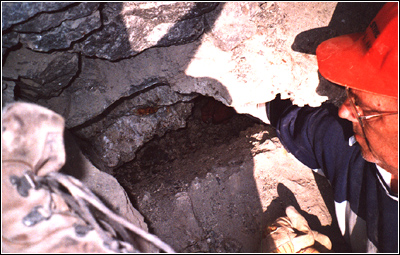
Figure 3: Sitting on the top of the pegmatite cavity, I am able to take this picture of my dad searching for a crystal. At this point we are able to find only broken pieces of microcline.
|
I placed against the wall a ladder so that my dad could safely join me and share my joy in helping extract the mineral specimens from the cavity. In the meantime I took some pictures. My dad began reaching for the specimens one by one (Figure 3), but the process by hand was slow and difficult, because there were broken crystals all around the opening. These crystals were sharp enough to cut our hands like blades, and there was no question of wearing gloves and loosing the feeling of the crystals in our fingers. I had to make the cavity opening wider. I started to hit the edge of the cavity with a chisel and a sledge hammer. The more I broke up the rock, the more I could see into the pocket. As I worked, I peeked inside the pocket to see if I could spot the tip of a nice crystal. And then it happened – the thing that happens when you don't concentrate on what you are doing – I give myself a good whack with the sledge hammer right on my hand. "Ouch!" My dad took over from me after he stopped laughing at me.
After a short while, I hear my dad calling out to me. I can tell he found something really good. Between all those broken pieces he found a giant crystal of quartz like I had never seen before (Figure 4). What a monster! My first thought was to grab it with my hand, but I quickly regained control of myself and ran to my truck to get my camera and to take picture of it. It was a question of proving to you that this was a real thing!
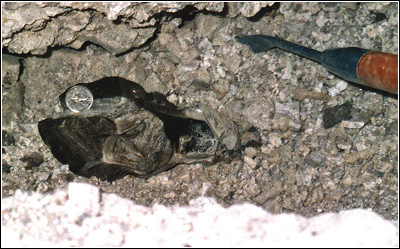
Figure 4: A superb bi-terminated crystal of quartz of about 19 cm long and 9 cm wide. It made me skip a hartbeat to find something like this. A quarter is shown for scale.
|
Funny how the pain in my hand could disappear so quickly when one sees such a crystal. I grab my tools again and go back to work to open up the cavity some more. What a pleasure to be able to feel the faces of a such a giant quartz crystal. I hold the crystal in my hand, but there was no question of taking that quartz out of the cavity just yet. Why? When exposed to the hot sun, smokey quartz explodes like grenades. My dad goes to the truck to get some newspaper to cover it before exposing it to the sun. As soon as it is wrapped, the crystal is stored under my seat in the truck. Now the big question is what else is inside that pocket cavity?
We begin to fill the bucket much faster in order to get to the bottom of that pocket. Many quartz crystals of different sizes pass through our hands.
All the quartz crystals are covered with a thin gray coating. Some of the quartz specimens are single crystals, and others are complex twins. Some look bizarre! Some are skeleton-like, others are like cathedrals with windows. On some of them we find all the minerals present in the pegmatites, like rutile, microcline, calcite, and donnaite. Just when I think I've reached the bottom of the pocket, I remove a big piece and it starts all over again – more crystals! Suddenly, I see the tip of a nice quartz crystal, but it refuses to move. "There it is now, it's got to be the bottom." So, I decide to clean around it taking care not to damage the tip of the crystal. I realise slowly that this quartz crystal is not small at all. I decide to use one of my wooden tools to try to move it a bit. Then I see most of the bottom of the pegmatite move ... My god, this one is enormous!
I remove all the broken pieces I can find. Voila! It's done. I stand in admiration in front of this masterpiece made of microcline and quartz (Figure 5). There is no way to get it out because it is too heavy. The giant specimen slides on the broken pieces of rock every time I try to pull it out of the cavity. I don't want to damage it. So I enlarge that cavity again until I am able to reach the bottom of the cavity with the upper part of my body. It is proving difficult to remove the giant quartz and time is running out. My dad then comes up with a good idea (it's always good to bring your dad with you, experience has no price). We will use two wooden sticks and use them like railroad tracks to slide the monster out. It's like trying to grab a giant noodle with Chinese chop sticks.
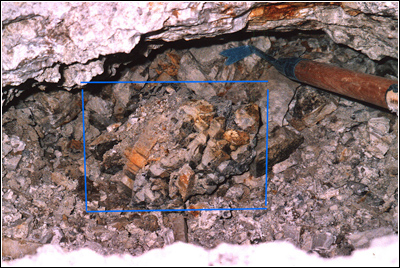
Figure 5: The monster of all monsters! A giant specimen of quartz and microcline It is 24 cm wide at the base. What a thrill it was to find this specimen. See also Figure 7A.
|
This piece is unbelievable! It is 24 cm (9.5 inches) long and it is made of 3 quartz clusters forming some kind of triangle (see Figure 7A). At its centre is a giant piece of microcline. Now I must say that I'm satisfied - you can't get better than this, and I'm convinced that there is nothing more spectacular to be found in that pocket. So I rush to empty the rest of broken pieces left in the cavity and suddenly I find many giant plates of microcline, up to 13 x 13 cm (5 x 5 inches) in size (see Figure 7D). They look like puzzle pieces for making some real giant crystal. On the tip of one plate I find a superb crystal of black sphalerite. But when held up to the sun, we can see it is a gem consisting of a deep green color with a thin black coating. After finding the giant quartz and sphalerite specimens, I believed my day was over, but it wasn't so.
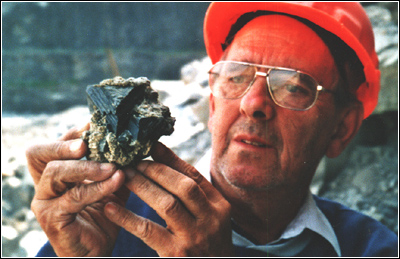
Figure 6: My dad holding one of the largest sphalerite crystals ever found at Mont. St-Hilaire. This amazing specimen was perfect and of gemstone-quality.
|
At the base of those microcline plates in the cavity, I see between them a dark object that looks like a ball. Gently, I hold up that ball with the tip of my fingers. As I touch it I can feel a rough surface – it is not a quartz crystals and it is kind of heavy for its size. When I finally see the specimen in sunlight, I realize it's another giant crystal that is completely clear and of true gemstone quality – enough so that it can be cut. It is a perfect, damage-free crystal of dark green sphalerite, 7.5 cm (3 inch) high. Amazingly, with all those broken pieces of microcline around it, it survived the blast. I extract from that area of the cavity four beautiful specimens of sphalerite and the most extraordinary one is a single crystal with a tetrahedral form, measuring 9 x 9 x 8 cm (about 3.5 x 3.5 x 3 inches) in size. Figure 6 shows my dad Roland is holding the sphalerite in is hand (see also Figure 7, E-F). A perfect beauty. When the pocket is finally cleaned, it was easy to follow the bottom of the pegmatite. It's just too bad the blast broke apart all those plates of microcline. Had they remained intact, the pictures I would have taken would have been as unique as those of the giant quartz and sphalerite crystals.
What a wonderful Sunday, and what sensation and discovery! When I think of how that day began when everyone was telling me there was nothing to be found, there I was driving my truck home with outstanding giant quartz and sphalerite specimens under and above my seats! You can see some of the giant specimens I found in Figure 7 above. To see larger versions of these pictures, visit my website (see below). These specimens may have set new records for Mont St-Hilaire.
I hope I was able to convey to you the thrill I had that Sunday in August 2002. If you have any comments, I am always happy to hear from you.

Explore from Here:
- Daniel Comtois' Québec Minerals
Daniel's newly re-launched website features stories and many photographs of outstanding mineral specimens he has collected in Québec.
Further Reading:
- Laszlo Horvath and Robert A. Gault. 1990. The Mineralogy of Mont Saint-Hilaire, Québec. Mineralogical Record.
21(4):283-392 (July-August).
Related Articles:
- Exceptionally Large Quartz and Sphalerite Crystals found at Mont Saint-Hilaire, Québec
By Dirk Schmid M.Sc. and Daniel Comtois
- Blue Coloured Quartz from Mont Saint-Hilaire, Québec
By Daniel Comtois
- Mont Saint-Hilaire
By Marc Favre
- How Mont Saint-Hilaire was Formed
By Martin van Kuilenburg
- Collecting at Mont Saint-Hilaire in 1997
By Laszlo and Elsa Horvath

Copyright © 2003 Daniel Comtois
E-mail: quebec-minerals@videotron.ca
Website:
Reprint instructions:
This article may not be copied, distributed or reprinted in any form without permission from the author. To contact the author, please use the e-mail address provided. If you are unable to contact the author, please contact the Canadian Rockhound. Authorized reprints must acknowledge the author and the Canadian Rockhound, and include the website URL address of the Canadian Rockhound.
All photographs appearing in this article were taken by Daniel Comtois and modified from the originals for the purpose of this article. Original photographs can be viewed online by visiting Daniel Comtois's website, or obtained by contacting Daniel Comtois directly by e-mail.
 more on copyright and reprints...
more on copyright and reprints...
How to cite this article:
COMTOIS, Daniel. Outstanding Giant Quartz and Sphalerite from Mont Saint-Hilaire, Québec. Canadian Rockhound [online]. 2003, vol. 7, no. 1. Available from World Wide Web: <http://www.canadianrockhound.com/2003/01/cr0307102_msh.html>.
 more on referencing electronic documents...
more on referencing electronic documents...
 Top of Page
Top of Page







